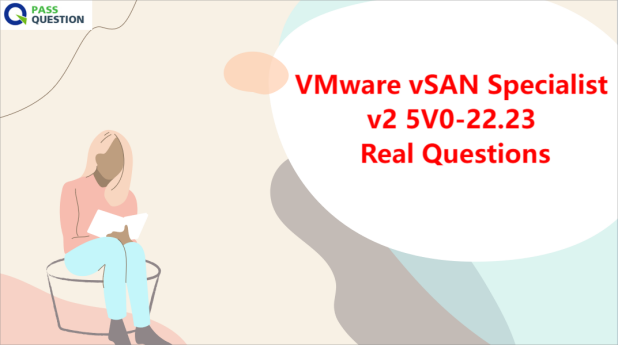VMware vSAN Specialist v2 5V0-22.23 Real Questions
If you're looking to excel in your 5V0-22.23 VMware vSAN Specialist v2 exam, then you'll want to be sure that you have all of the resources and support you need to succeed. And one of the best resources available to you is the latest VMware vSAN Specialist v2 5V0-22.23 Real Questions from PassQuestion. These Real Questions are specifically designed to help you prepare for your exam by providing you with a comprehensive overview of the types of questions you can expect to encounter, as well as valuable insights into the subject matter. By studying these VMware vSAN Specialist v2 5V0-22.23 Real Questions, you'll be able to identify any gaps in your knowledge or areas where you may need to focus more attention, allowing you to tailor your study plan accordingly. With their comprehensive coverage and up-to-date information, you'll be well on your way to exam success in no time!

5V0-22.23 Exam Overview - VMware vSAN Specialist v2
This exam tests candidate skills and abilities designing, implementing, and administering a VMware vSAN environment. The VMware vSAN Specialist v2 Exam (5V0-22.23), which leads to the VMware Certified Specialist – vSAN badge, is a 76-item exam with a passing score of 300 using a scaled method. Exam time is 125 minutes.
The minimally qualified candidate (MQC) must have earned a VCP/ VCAP/ VCIX / VCDX 2021 or newer. It is recommended the MQC have 6-12 months hands-on experience configuring, managing and designing vSphere and vSAN. The MQC is also experienced in deployment and administration of VMs using Storage Policy-Based Management and has basic knowledge of: storage, networking, hardware, security, and monitoring and troubleshooting. The MQC should possess the majority of the knowledge of the objectives shown in the exam sections in this guide.
Exam Details
Exam 5V0-22.23 : VMware vSAN Specialist v2
Associated Certification: VMware Certified Specialist - vSAN 2023
Language: English
Number of Questions: 76
Format: Single and Multiple Choice, Proctored
Duration: 125 Minutes
Passing Score: 300 (scaleD.
Pricing: $250
Exam Topics
Section 1 – Architecture and Technologies
Section 2 – Products and Solutions
Section 3 – Planning and Designing
Section 4 – Installing, Configuring, and Setup
Section 5 – Performance-tuning, Optimization, and Upgrades
Section 6 – Troubleshooting and Repairing
Section 7 – Administrative and Operational Tasks
View Online VMware vSAN Specialist v2 5V0-22.23 Free Questions
1. When attempting to add a directly attached disk device to a host disk group, the intended disk does not show among the available devices in disk management. Which action should be taken?
A. Create a 1GB metadata partition
B. Format the existing partition
C. Create a VMFS partition
D. Delete all device partitions
Answer: D
2. A vSAN administrator is troubleshooting poor performance of vSAN cluster while vCenter is not available. The vSAN administrator decides to use a command line tool to monitor real-time vSAN IOPS, throughput, and other metrics on ESXi host.
Which command line tool should be used?
A. vimtop
B. esxcli
C. esxcfg
D. vsantop
Answer: D
3. What are two purposes of a vSAN storage policy? (Choose two.)
A. To determine vSAN encryption level
B. To enable TRIM/UNMAP
C. To define how the VM storage objects are provisioned
D. To guarantee the required level of service
E. To enable deduplication and compression
Answer: C,D
4. A vSAN administrator is using the vSAN ReadyNode Sizer to build a new environment. While entering the cluster configurations, a fellow colleagues inquire about the Operations Reserve option. What is the purpose of using this option?
A. Configures space for external operations
B. Provides space for internal operations
C. Reserves space for tolerating failures
D. Allocates space for vSAN upgrades
Answer: B
5. The Resyncing Objects view in the vCenter UI reports that some objects are currently resyncing. Which two actions would cause this situation?
(Choose two.)
A. DRS is relocating VMs between vSAN nodes.
B. HA Virtual Machine Monitoring forced a VM to reboot.
C. A host failure occurs in the cluster.
D. A change to the storage policy is applied to the objects.
E. A VM snapshot is being deleted.
Answer: C,D
6. A vSAN administrator is receiving complaints that applications are not performing as expected. The vSAN administrator opens the vSAN cluster performance charts to try to identify the issue, but the vSAN cluster performance charts are not available.
Which option should vSAN administrator enable to make these charts available?
A. vSAN Performance Diagnostics
B. vSAN Troubleshooting Diagnostics
C. vSAN Performance Service
D. vSAN Troubleshooting Service
Answer: C
7. Which two conditions should be verified before removing an ESXi host from a vSAN cluster? (Choose two.)
A. Resyncs are running
B. Data evacuation is complete
C. Performance Service is disabled
D. Encryption is disabled
E. ESXi host is in maintenance mode
Answer: B,E
8. The objects on a 4-node vSAN cluster are assigned a RAID-5 policy. A network outage occurs, causing host one to lose connectivity with the rest of the cluster. Seventy-five minutes have elapsed. What is the health state of the objects?
A. Reduced availability with no rebuild
B. Non-availability related incompliance (non-compliance)
C. Reduced availability
D. Reduced availability with no rebuild – delay timer
Answer: A
9. What is the purpose of host rebuild reserve in vSAN?
A. Reserves space in case of single host failure
B. Allocated capacity for vCLS
C. Reconfigures data components
D. Stores vSphere HA heartbeats
Answer: A
10. Which two actions are recommended when adding a host to a vSAN cluster? (Choose two.)
A. Disable vSphere High Availability (HA. .
B. Create uniformly-configured hosts.
C. Reference the VMware Compatibility Guide.
D. Disable vSphere Cluster Services (vCLS).
E. Disable vSAN performance service.
Answer: B,C
- TOP 50 Exam Questions
-
Exam
All copyrights reserved 2025 PassQuestion NETWORK CO.,LIMITED. All Rights Reserved.

